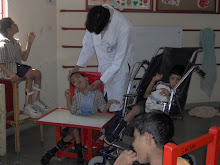Transfer of the patient from the wheelchair can be a scary experience for both the patient and the inexperienced dentist. Factors that will determine the actual success of the transfer include
- · Whether the patient is able to transfer himself or requires assistance
- · The Ability of the care giver to give help
- · The skill and experience of the dental staff
Keeping in mind the above mentioned parameters the National Institute of Dental and Craniofacial Research (NIDCR) has proposed the following six steps to a safe wheelchair transfer
STEP 1: Determine the patient's needs
Ask the patient or caregiver about
a) preferred transfer method
b) patient's ability to help
c) use of special padding or a device for collecting urine
d) probability of spasms
Reduce the patient's anxiety by announcing each step of the transfer before it begins.
STEP 2: Prepare the dental operatory
· Remove the dental chair armrest or move it out of the transfer area.
· Relocate the hoses, foot controls, operatory light, and bracket table from the transfer path.
· Position the dental chair at the same height as the wheelchair or slightly lower. Transferring to
STEP 3: Prepare the wheelchair
· Remove the footrests.
· Position the wheelchair close to and parallel to the dental chair.
· Lock the wheels in place and turn the front casters forward.
· Remove the wheelchair armrest next to the dental chair.
· Check for any special padding or equipment
STEP 4: Perform the two-person transfer
· Support the patient while detaching the safety belt.
· Transfer any special padding or equipment from the wheelchair to the dental chair.
· First clinician: Stand behind the patient. Help the patient cross his arms across his chest. Place your arms under the patient's upper arms and grasp his wrists.
· Second clinician: Place both hands under the patient's lower thighs. Initiate and lead the lift at a prearranged count (1-2-3-lift).
· Both clinicians: Using your leg and arm muscles while bending your back as little as possible, gently lift the patient's torso and legs at the same time.
· Securely position the patient in the dental chair and replace the armrest.
| THE TWO-PERSON TRANSFER | |||||
| | ||||
STEP 5: Position the patient after the transfer
· Center the patient in the dental chair.
· Reposition the special padding and safety belt as needed for the patient's comfort.
· If a urine-collecting device is used, straighten the tubing and place the bag below the level of the bladder.
STEP 6: Transfer from the dental chair to the wheelchair
Position the wheelchair close to and parallel to the dental chair.
· Lock the wheels in place, turn the casters forward, and remove the armrest.
· Raise the dental chair until it is slightly higher than the wheelchair and remove the armrest.
· Transfer any special padding.
· Transfer the patient using the two-person transfer (see step 4).
· Reposition the patient in the wheelchair.
· Attach the safety belt and check the tubing of the urine-collecting device, if there is one, and reposition the bag.
· Replace the armrest and foot rests.








No comments:
Post a Comment